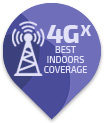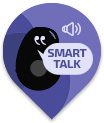Roaming Sim – Rogers, Telus, Sasktel, Tbaytel & Bell
Unlimited emergency voice & text using the best signal from either Rogers, Telus, Bell, Tbaytel, MTS or Sasktel – depending on where you are at any given time.
Included in your purchase will be a Live Life Alarms roaming sim card with unlimited emergency voice and text for the first year of use. Our sim card will pick the best mobile tower in your area whether it’s Rogers, Bell, Telus, Tbaytel, MTS or Sasktel. Then it’s just $75 each year from Year 2. Towards the end of Year 1 you’ll be reminded to add a $75 top up to continue to use the service for the following year. Your mobile alarm will even automatically work when you visit the USA – at no extra cost.
If you would like to enjoy the best coverage in Canada and never have to worry about running out of credit when you need it the most then you should select this plan. We’ve worked hard to tailor a custom plan with Canada’s six largest mobile operators that’s affordable and will never let you down.
Advantages
- Never worry about running out of credit when you need it the most.
- No need to check websites to see how much credit is remaining on your alarm.
- You’ll have access to the best network signal no matter where you are in Canada.
- With this plan we can remotely update the software in your device as improvements become available.
- No need to even think about cost per minute or cost per text. We’ve got you covered.
- Set and forget plan. No hassles.*
*Fair use policy applies. The Live Life mobile alarm is an emergency device and we expect it to be used as such.
Checking and topping up your credit
Before the end of Year 1 we’ll send you reminders to add another $75 for the coming year.
What happens if my prepaid credit runs out?
It won’t! We won’t let it! Your Mobile Alarm will always work.
Mobile Coverage disclaimer
The Coverage Maps are approximate only. Actual mobile alarm coverage depends on where you are and the device you are using. Customers should be aware that the mobile coverage maps displayed have been created using tools that predict the likely areas of coverage.
Not every particular location within the identified coverage areas has been individually tested for coverage. This means that while the footprint of coverage outlined on the maps is generally accurate, there will be specific areas described as being within a coverage area where a customer’s mobile alarm will not work.
This is a common characteristic of wireless systems. For example, coverage could be degraded or non existent in specific locations due to certain physical structures or geographic features or as a result of the device used. Physical structures which may block or inhibit coverage could include basements, lifts, underground car parks, concrete buildings, tunnels and road cuttings. Geographic features which may block or inhibit coverage could include formations such as hills and mountains or even trees.
Bluetooth disclaimer
Bluetooth is a technology that allows devices to communicate and share data over short distances without wires. Inside the charging station (or Home Beacon) that you received with your alarm is a Bluetooth 5.0 beacon.
We have (in nearly all cases) preprogrammed the wearers address to the latitude/longitude of the home. We have also paired the pendant to the Bluetooth beacon so they are connected. Bluetooth location provides an accurate and fast solution to your location during an emergency in and around the vicinity of your home. Bluetooth (sometimes referred to as BLE by us) also has less power consumption than other location tools, such as GPS and/or wifi.
This is one way we are able to get the Live Life Alarm to last as long as 12 days between recharges. Our testing indicates that Bluetooth can be relied upon to provide fast positioning when the alarm is within 25 metres of the Bluetooth beacon (Home Beacon). Once the alarm is outside this range it will attempt to obtain location via GPS or wifi.
wifi location disclaimer
Wi-Fi location tracking is a geolocation system that uses the entire Wi-Fi infrastructure (phones, tablets, laptops, and routers) as Wi-Fi access points to determine a device’s location. Wi-Fi location tracking is a good system for geolocation whenever the Global Positioning System can’t get the job done. For example, GPS can’t always locate your device when you’re indoors, as the signal coming from GPS satellites is weak or easily blocked. wifi works by comparing this list of Wi-Fi networks near you to a known list of access points and their locations.
In your Live Life Alarm is a wifi chip module. In an emergency, the Live Life Alarm will look for wifi access points to calculate your position. If a location solution can be found faster than using GPS then your wifi location will most likely be reported on Google Maps to your emergency contacts. However, the alarm will always look for a Bluetooth location solution first. If you find yourself in an area such as a rural setting or out in the country then there is likely to be less wifi access points than in a more built up area. In cases such as these the Live Life Alarm will more likely resolve to a GPS position. If wifi position is reported in such instances then it is possible the accuracy of the location could be less than ideal.
GPS functions disclaimer
The LiveLife Mobile Alarm has built-in GPS technology that it uses to fix the location of the pendant with an accuracy of 2 metres. In order for the GPS functions to work it requires a line-of-sight connection to satellites in the sky. For the pendant to receive the signal it needs to be pointed to the sky. It normally takes a few seconds to receive the signal and work out the co-ordinates of it’s exact location. It can take up to 10 minutes to get it’s first fix out of the box.
In the event that the pendant cannot receive the GPS signal it will revert to showing it’s last known position. This is the location of the device when it was last able to fix it’s location by satellite. The device conserves power by only trying to get a GPS fix when the device is moved. Because of this we cannot guarantee that when the device is activated the location given is always the current position at the time of activation or that when someone tries to locate it via sms that it will know it’s current position. With that said, if the device does not know it’s current position it will report it’s last known position. This usually means the alarm has not moved significantly from it’s last known position so in most cases this is actually the true location of the Mobile Alarm.
Underground carparks, lifts, concrete buildings, tunnels and other constructions can block the signal from satellites to the pendant. It is possible that if a wearer of the pendant is in a location where there is no GPS signal that there may also be no 3G mobile signal meaning the function of the pendant will not operate till the wearer moves to an unobstructed location.





